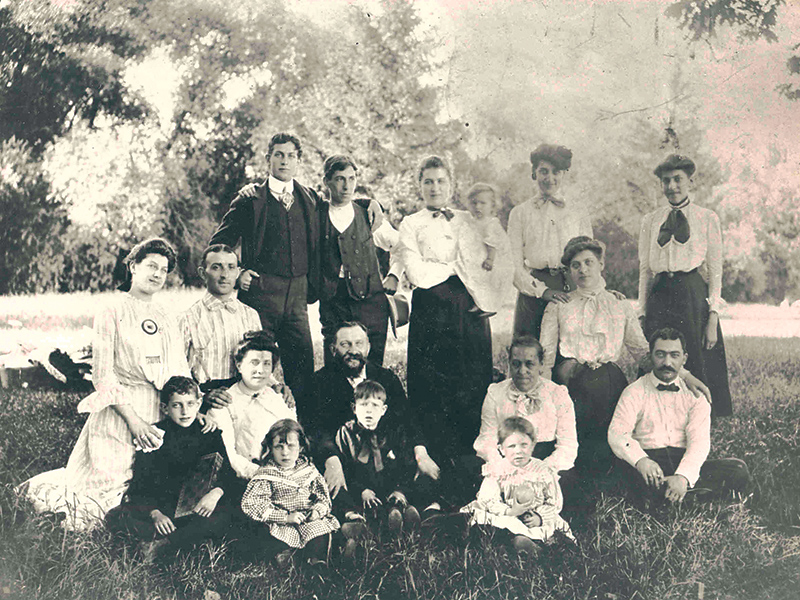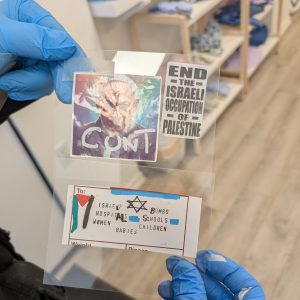When Ida Lewis Siegel turned 90, Canadian Jewish Congress official Ben Kayfetz wrote an article celebrating her many accomplishments within Toronto’s Jewish community, noting that she had devoted her life to the community’s welfare and that she was still in possession of an impressive memory.
“She can recite from memory the addresses and identities of every Jewish (and non-Jewish) storekeeper in the old ward, along Queen Street West, down York Street and in the Elizabeth-Chestnut-Centre Avenue sector,” Kayfetz observed.
Both of those factors – Siegel’s deep involvement in Toronto’s early Jewish community, and her long-standing practice of writing down or reciting her anecdotes and memories from the old days – are the reason the Ontario Jewish Archives Blankenstein Family Heritage Centre has such an impressive range of material on her.
READ: ARCHIVES HOUSE VALUABLE ARTIFACTS OF CANADA’S JEWISH LEFT
Siegel (1885-1982) was born in Pittsburgh but her mother – an activist in Jewish affairs in her own right – brought her as a little girl to Toronto where her father had already taken up residence. They took a train to Lewiston, stopped to view Niagara Falls, then crossed the lake on the Iroquois steamer to Toronto. “I immediately loved Canada and still do,” she wrote in a reminiscence many years later.
In a short essay The Old Time Family Doctor, Siegel recalled the days when a family member would rush to the closest telephone in a local saloon when an expectant mother went into labour. “Not even the most retiring woman hesitated to enter the saloon when the doctor was needed – and he always came, in response to the saloon telephone, early or late, in his horse and buggy.”
Siegel’s brother, Samuel Lewis, organized the city’s first Zionist organization, Agudath Zion, in 1898, a time when the Zionist movement was gaining huge momentum and the Dreyfus case of France was “uppermost in the minds of the people.” In 1899 Ida Lewis (before her marriage) presided over the first meeting of Daughters of Zion, the first women’s Zionist organization in Canada, in her home on Elizabeth Street near Dundas Street. Profits from their popular balls, held annually in the Temple Building, were sent to aid the Jews of Palestine.
Numerous other Zionist groups sprang up, including the Zion Cadets, which marched in a city-wide military parade in 1905. Another group, Ohavis Zion (Love of Zion) began as a mixed organization open to both young men and women. However, as Siegel noted, “it lasted only six months because, as was said, there was too much Ohavis and not enough Zion.”
There was only one cheder in town in those years, the Talmud Torah located on “aristocratic” Simcoe Street, which later moved to Brunswick Avenue. Its much-respected principle and teacher was Benzion Nathanson. “He carried no stick around with him, and when out of patience [did not] deliver a Rooshesen frank – a Russian slap – like one I knew in a Sunday School.” Instead, Nathanson “merely pleaded” with his pupils to behave.
READ: HISTORY OF TORONTO’S YIDDISH THEATRE ON DISPLAY AT ONTARIO JEWISH ARCHIVES
Siegel lamented the lack of educational resources for girls, and established the Zionist Sunday School for girls above Caplan’s Butcher Shop on Dundas west of Elizabeth. A suffragette sympathizer, Siegel drew inspiration from her friend, Hadassah pioneer Henrietta Szold, as well as from feminist Susan B. Anthony, whom she once met in New York State.
She was instrumental in founding Hadassah in Canada, the Hebrew Ladies Maternity Aid Society, the YM and YWHA, the Goel Tzedec Sisterhood, and the city’s Toronto Home and School Council. In between these doings, she served on the Talmud Torah Auxiliary, the Women’s Auxiliary of the Beaches Institute, the Child Welfare Council of Toronto, and other charitable enterprises. A tireless charitable organizer, she was also, impressively, a mother of six.

Through her vision to create a Cooperative Board of Charities, she influenced local charities to work together and led to the Federation of Jewish Philanthropies of Toronto and the present-day Federation. Her unstoppable ambition to improve the lot of the less fortunate led her to run for a seat on Toronto’s Board of Education, to which she was elected in 1930 despite “stiff opposition from every source,” she wrote. “The feeling behind it was that, once elected, it would be hard to keep the Ward spot open for ambitious young men, as a stepping stone to higher political positions.”
In the WW I era, the Toronto YMCA ruled to keep a Jewish boy from joining. Siegel tried to interest the Jewish community in a sports facility of their own, but many felt that fundraising for the Talmud Torah was more important. Undaunted, she rented space in an adjacent building where young people could enjoy sports and exercise. After a sports team headed by Jack Landsberg won a first victory against the Balmy Beach Club, Siegel was hastily summoned because a fight had broken out on the field.
“As I approached, Jack Landsberg came toward me saying triumphantly, ‘They won’t call us kikes again,’” she recalled. Many laughed at the idea of joining sports and Talmud Torah together, but when the YM and YWHA came into existence, it was in association with the Talmud Torah, just as Siegel had envisioned.
Siegel knew all about backroom politics. She was once part of a group that confronted the autocratic president of the B’nai Zion Society for his inability to produce a financial statement. “The matter came to a head at a convention held at an old church at the northeast corner of Terauley and Agnes (now Bay and Dundas) when Abe Lewis had the temerity to rise and ask president De Sola ‘when the executive would for the first time, present a financial statement,’ only to be shouted down by De Sola – ‘Lewis get out, out.’”
In 1937, Siegel ran for alderman in Ward Four but lost the election and never tried again. The record of all these episodes in an astonishingly full and active life have been preserved in diaries, reminiscences, correspondence, speeches, scrapbooks, news clippings, oral histories and photographs. Plenty of grist here for the historian’s mill.
This is the fifth in a series of seven articles about the Ontario Jewish Archives Blankenstein Family Heritage Centre to be published periodically, funded by the J.B. & Dora Salsberg Fund at the Jewish Foundation of Greater Toronto. This series is in partnership with the Ontario Jewish Archives, Blankenstein Family Heritage Centre, and draws on their collections: www.ontariojewisharchives.org.






